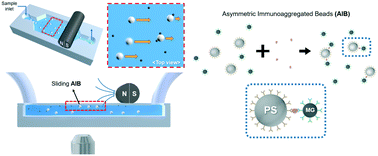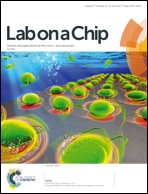Asymmetric bead aggregation for microfluidic immunodetection†
Abstract
We report an asymmetric immunoaggregation assay for rapid, label-free, and sub-picomolar protein detection. Asymmetric immunoaggregated beads (AIBs) are formed when binding occurs between 1 μm magnetic (MG) and 2.8 μm polystyrene (PS) beads coated with specific antibodies for a target antigen. Detection of such aggregation is achieved by optical monitoring of AIBs in a flow under an external magnetic field. AIBs are attracted to the upper surface of the microchannel by a magnetic field and made to slide along the surface by a flow drag force. This sliding behavior is in contrast with other particles such as MG and PS beads; while attracted MG beads hardly slide due to their small size, PS beads quickly move with the flow due to the lack of magnetism. Sliding AIBs are optically monitored in a designated sensing area in the microchannel. A custom-built program code is used for counting the AIBs and further analysis of parameters such as velocity and number distributions that are correlated with target concentrations. The detection range from 54 pg mL−1 to 54 ng mL−1 is demonstrated for the influenza type A H1N1 nucleoprotein (NP). This immunosensing system is simple, highly sensitive, and capable of quantitative detection of antigens in a single test without fluorescent or enzyme labeling, hence is useful for the rapid detection of biomarkers in clinical and biomedical applications.



 Please wait while we load your content...
Please wait while we load your content...